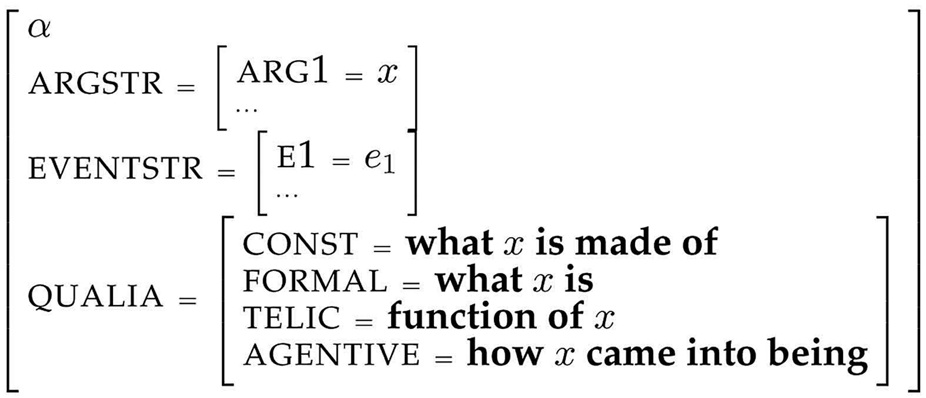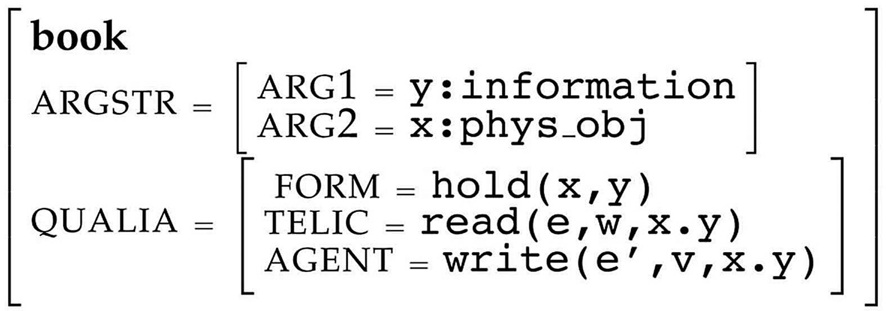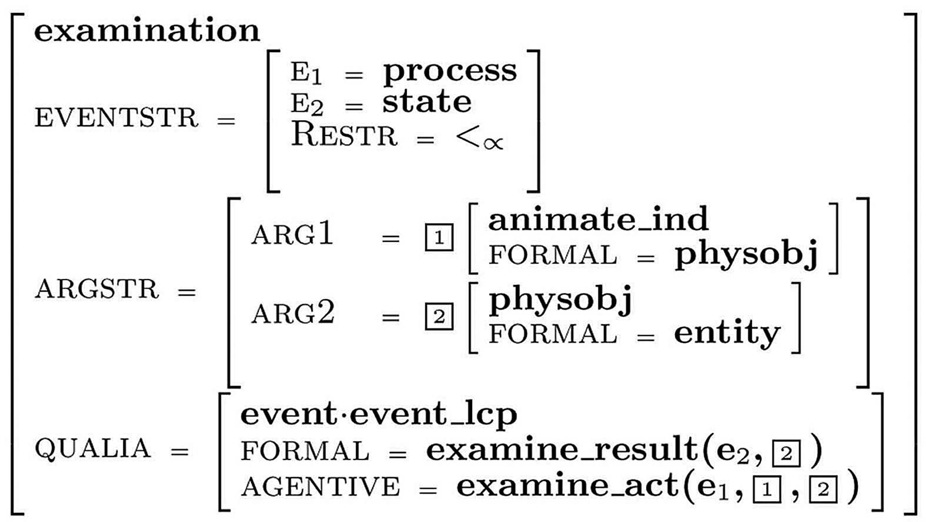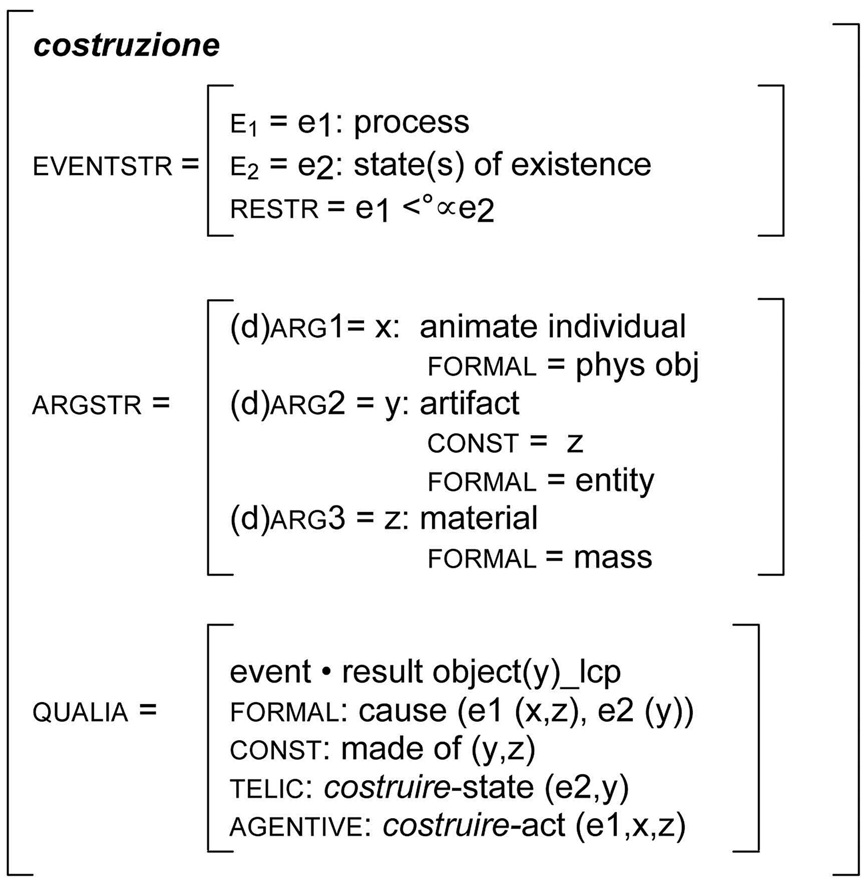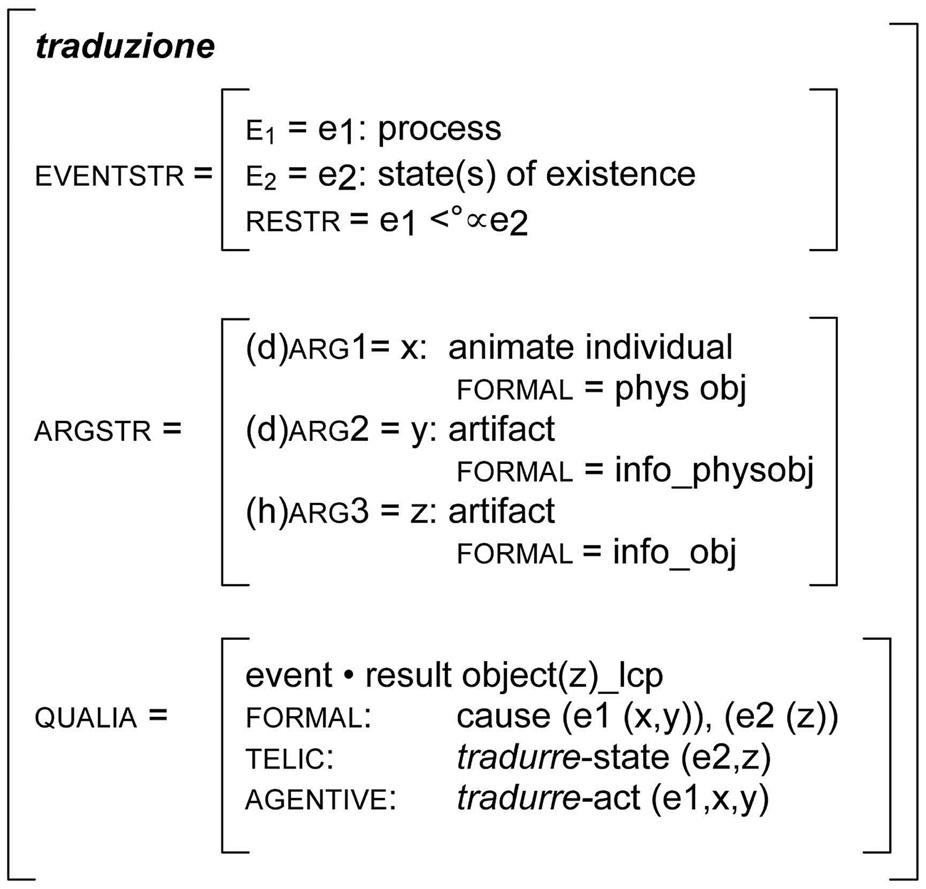


In this paper, we examine the event/result meaning contrast displayed by Italian nominals derived from creation and redescription verbs, such as costruzione ‘construction, building’ and traduzione ‘translation’. The goal of our research is twofold. First, we intend to verify whether the intriguing pattern of polysemy exhibited by these nominals may be analyzed as a special case of complex type, with the two constituents of the type analyzed as PROCESS and RESULT-STATE, as proposed in Pustejovsky (1995). Second, we want to clarify what factors might be causing the difficulty in co-predication (i.e. simultaneous access to both subtypes, commonly regarded as the test for complex types) that these nominal typically exhibit. Results of this study can be summarized as follows: the RESULT-STATE interpretation (i.e. construction as ‘the state of being constructed’) appears not to be generally accessible to these nominals, and copredication appears to be licensed only under specific syntactic and semantic conditions. We claim that both behaviors follow from the inherent properties of the event associated with these nominals, which encodes a peculiar temporal relation between the subevents. Based on this insight, we propose a revised modelling of the lexical representation of creation and redescription nominals within the Generative Lexicon (GL) framework, informed by empirical evidence. The results of our study help to provide a better understanding of the phenomenon of lexical polysemy and the interplay between aspectual and lexical properties of Action Nominals.
This paper deals with the event/result polysemy pattern displayed by
The event/result meaning contrast displayed by these nouns has been the subject of several theoretical investigations, especially because of the challenging syntactic corollaries related to their semantic ambiguity (cf. Grimshaw, 1990; Alexiadou, 2002). Much less attention, however, has been paid to the phenomenon from a lexical-semantic perspective. Asher (1993) and Pustejovsky (1995) tackled this issue by focusing on the syntactic and semantic structures of the base verbs, and pointing to different formal solutions.
Based on the achievements of previous works on polysemy (cf. Copestake and Briscoe, 1995), the overall aim of this paper is twofold. First, we intend to verify whether the intriguing pattern of polysemy exhibited by these nominals may be analyzed as a special case of
The structure of the paper is as follows. In section 2 we introduce the classification of complex types in GL theory, paying particular attention to those exhibiting polysemy between event and result readings (section 2.1). In section 2.2 we summarize the issues raised by this analysis and illustrate our theoretical claims, while in section 2.3 we illustrate the methodology we adopted in collecting and examining the empirical data. In sections 3 and 4 we give a unified account of the results of our investigation. We first propose a revised lexical representation for EVENT•RESULT-OBJECT nominals and then spell out the co-predications constraints observed in the data. In section 5 we draw our conclusions and locate the results of our study within a broader perspective.
In our analysis of ANs’ polysemy, we assume the GL model as our theoretical framework. Classic GL (Pustejovsky, 1995) proposes that the linguistic knowledge associated with a lexical item may be represented through four informational structures,
The Argument Structure captures the participants in the event described by the predicate. GL introduces a distinction between three primitive argument types:
The Event Structure identifies the specific event type for a verb or phrase. The primitive event types posited in GL are:
Qualia Structure consists in four distinct relations, each capturing an essential aspect of the meaning of a word:
The different meaning dimensions listed above can be represented as a set of features. GL lexical representations are grounded in terms of typed feature structures. The feature representation as shown below in Figure 1 gives the basic template of argument and event variables, and the specification of the Qualia structure for a lexical item α.
In GL, Qualia roles are used as a basic vocabulary to define the conceptual categories associated with lexical items (semantic types). Pustejovsky (2001) proposes a ranking of types distinguishing between natural and artifactual types, and then complex types, defined as follows.
Complex types (or dot objects) are reifications of multiple types, bound by a coherent relation. For example,
Complex types were introduced in GL to account for cases when a single word or phrase has the ability to appear in selected contexts that are contradictory in type specification, i.e. in co-predication constructions. For example, in (3) the two senses of
In Figure 2 we report the proposed GL lexical representation for the complex type
The type of polysemy exhibited by words associated with complex types is referred to as
Having defined the notion of complex type generally, in the next section we turn to the analysis of complex types represented by ANs.
2.1 Complex types for action nominals
In GL theory, nominals displaying the event/result meaning contrast are classified as complex types. That is, it is assumed that the event/result senses of ANs are an instance of
Regarding the internal composition of AN’s dot types, Pustejovsky (1995) proposes to analyse them as EVENT•EVENT or, more specifically, PROCESS•(RESULT-)STATE. In particular, the author claims that for -
Moreover, according to the author, for nominalizations which are derived from verbs of creation (e.g.
The representation proposed for PROCESS•RESULT nominals in GL differs from that proposed for PHYS•INFO complex types such as
The research on nominal polysemy patterns, conducted adopting the notion of complex type, has brought about several intriguing puzzles about this class of alleged dots.
A first issue concerns the nature of the types making up the complex. While Pustejovsky argues in favour of a PROCESS•(RESULT-)STATE polysemy extended to creation nominals, other studies (cf. Apresjan, 1974; Bierwisch, 1991; Asher, 1993; Asher and Denis, 2005; Osswald, 2005; Bisetto and Melloni, 2007; Melloni, 2007; Ježek, 2008) introduce, in addition to events and states, other sortal types for the result reading, such as CREATED OBJECT or RESULT OBJECT.
A second issue concerns co-predication. Co-predication is generally considered as a reliable diagnostic for identifying dot types: since they are type bundles, dot objects should license predications over either of the two (or more) constituent types. However, it appears that only certain ANs can enter co-predicative contexts and they can do it only in certain syntactic and semantic conditions, including temporal disjunction between the types, omission of the internal argument and insertion of a relative pronoun (cf. Jacquey, 2001 for a thorough analysis of French ANs in co-predication contexts). Consequently, the dot nature of ANs is not uncontroversially accepted, and other scholars have pursued alternative research lines. For instance, Asher and Denis (2005) propose that creation ANs are an instance of disjunctive types / homonymy, and Brandtner and von Heusinger (2010) defend the meaning transfer hypothesis in the line of Nunberg 1995.
In the present study, we tackle both of the contentious issues raised above. In particular, we show that the (RESULT-)STATE analysis proposed in GL for the result reading of nominals derived from creation verbs is not fully supported by empirical data, and we argue that this is expected because the proposed analysis of the event structure of these nominals does not take into account the distinction between standard causatives and accomplishments taking an incremental theme. The latter class, in fact, includes traditional creation and redescription verbs, which, like consumption verbs and other classes, encode a peculiar temporal relation between the subevents. Therefore, in what follows, we argue that it is the verb event structure that straightforwardly accounts for the polysemy pattern of creation and redescription nominals, which, as the data will show, are in fact unable to refer to a result state.
Furthermore, we argue that the peculiar temporal structure of the event associated with these nominals is responsible also for the constraints on the simultaneous activation of the event and the result reading in co-predication structures. In particular, we claim that the causal asymmetry existing between the event and the result type, according to which the performance of the event is the precondition for the coming into existence of the result, licenses copredication with these nominals only in specific conditions.
Starting from an accurate analysis of the semantic and syntactic behaviour of these nominals as attested in the corpus, in the last part of this paper we will show that an analysis of this special case of polysemy, conducted along the lines sketched above, can explain the inaccessibility of the resultstate reading as well as the attested troubles with co-predication.
2.3 Methodology for Empirical Investigation
In our empirical investigation, we examine selection contexts extracted from corpus data, where either one sense (EVENT or RESULT) or both senses (EVENT and RESULT) of deverbal nominals is/are instantiated.2 In order to establish which sense(s) is/are activated in context, we pay attention to the selectional properties of the adjectival and verbal collocates of ANs, which, following Rumshisky (2007), we call
While in section 3.2 we mainly deal with data highlighting a single aspect of the complex sense of the ANs under discussion, in section 4, we focus on contexts in which both senses are simultaneously activated (
1For formal details, see Asher and Pustejovsky (2006). 2Our dataset is extracted from the ITWaC corpus (Italian Web as Corpus; cf. Baroni and Kilgarriff, 2006) using the Word Sketch Engine corpus query tool (Kilgarriff et al., 2004).
3. Empirical Findings and Theoretical Analysis
In this section, we present the results of our research, and put forth an explanation for some of the puzzles posed by the data. We first examine the actual contexts looking at the selectors that highlight the constituents of these complex types, and then challenge some of Pustejovsky’s (1995) claims (3.1). Our explanation for the data calls into play event structure theory and is mainly grounded on Levin and Rappaport Hovav’s work on verb semantics (1998, 1999, in particular), which is incorporated here in Pustejovsky’s GL framework (3.2). A formal modeling of the ANs at stake is attempted in section 3.3. Finally, in section 4, we turn to the analysis of co-predication contexts, discuss the constraints identified in our study and offer a possible interpretation based on the subeventual analysis proposed in section 3.2.
3.1 Result State or Result Object?
In this section we examine whether the polysemy patterns displayed by ANs can in fact be reduced to the EVENT•(RESULT)STATEpolysemy proposed in Pustejovsky (1995). In general, our analysis confirms that the (RESULT-) STATE interpretation is available to several deverbal nominals. For example, both
b.
‘The obstruction may be temporary or permanent’
c. Questo test permette di capire esattamente dove si trova l’
‘This test allows to understand exactly where the obstruction is’
Concerning
The (result-)state interpretation, however, is generally not accessible to nominals obtained from verbs expressing events which put a new entity into existence. In other words, nominals such as
The first predicate in (11) (
While the state reading is not available, creation and redescription nominals can instead refer to the concrete or abstract objects obtained by the associated event, as we can see from the example below:
This is a polysemy pattern that is common to almost all creation nominals (e.g.
Since, as we have seen above (ex. 9/10), there are ANs (derived from causative verbs) that can refer to the process/event, to the result state, and to the created object, the question we address next is: what blocks the state interpretation for creation and re-description nominals like
3.2 An Event Structure Analysis of Creation/Redescription Verbs
The analysis of nominals polysemy we propose in this section takes into account the semantics of the verb which is the base of the nominalization process. Building on recent work on verb semantics, we suggest that Pustejovsky’s (1995) analysis of event structure, which motivates the PROCESS•STATE polysemy of ANs such as
We thus argue that it is verb event structure which straightforwardly accounts for the polysemy patterns of creation and redescription nominals, which are in fact unable to refer to a result state. We will now elaborate on this point (for further explanation, cf. Melloni, 2007 and Ježek and Melloni, 2009).
Verbs such as
Co-identification of the constituent subevents in a complex event structure is defined as the relation that holds between subevents that are distinct in terms of conceptual structure but that can be represented as a single simple event in ES terms if the following conditions are met:
As for creation and re-description predicates such as
It is worth noticing however that, in order to account for the flexible syntactic manifestation of incremental theme verbs, Levin & Rappaport Hovav equate this class with the aspectual class of process/activity verbs, which differ from standard accomplishments in several important respects, most importantly, homogeneity (see Bach, 1986 on this topic). Moreover, in their analysis it is not easy to capture the relation holding between the subevents in the complex predicate, if any. It cannot really be a causative relation, as indicated in the LCS in (13), since, as it is well known, Cause implies precedence. That is, if Cause holds between a subevent P and a subevent S, then P precedes S. Intuitively, however, Cause is the very relation at stake in creation and redescription events: in order for a house/translation to exist, there must have been a building/translating process bringing it into existence. The building/translating process is a sufficient condition for the existence of the house. Hence, we raise the question of whether and how it is possible to combine Levin & Rappaport Hovav’s considerations on incrementality and Event Structure with the temporal ordering of subevents implied in causal structures.
The hypothesis we pursue is that, given a causative structure, the two subevents composing it may or may not overlap. In the case of creation predicates, the causing event precedes the state subevent (corresponding in fact to a series of existence states) which is in complete overlap with the former, as schematically represented below:
In this analysis, however, E2 is not only co-extensive but is also temporally dependent on E1 because of the incrementality of the theme, as predicted in event co-identification theory (cf. point a, above).
The temporal constitution of these complex events can be captured in the GL theory of ES with the relation <°∝ holding between E1 and E2, which means precedence and overlap. In this respect we depart from Pustejovsky (1995), who proposes simple precedence <° for accomplishments such as
The crucial point for the present analysis of the polysemy of nominals is that, in this view, since the causing process (E1) overlaps the state subevent (E2), there is no independent access to the BECOME subevent and to the resulting STATE either. Such inaccessibility to the state, we argue, is inherited by the nominal, which is therefore incapable of yielding a result state interpretation.
On the contrary, the result state interpretation is available to those nominals which are derived from causatives implying no temporal overlap and in which a certain (reversible/transitory) state is independently represented in the temporal ordering of the event, as in
In this section, we present a proposal of lexical representation for the complex types
3.3.1 Creation nominals
In Figure 5, we propose a GL-modeled lexical representation for construction.
Our proposal is grounded on the assumption that event and argument structures of the base verb are inherited by the corresponding derived nominal (see Melloni 2006, 2007 and Ježek 2009 for proposals along these lines). The Event Structure of
As for Qualia Structure, our representation in Figure 5 is in line with the representation proposed in classic GL for standard dot objects like
Specifically, as for the noun
In this way, our representation is able to capture the polysemy between the
Let us now turn to the other Qualia in the lexical representation. In line with the discussion on the asymmetry between the types in the complex in section 3.2, our formal modeling envisages a split Qualia representation. More specifically, we propose that the predicates in the qualia roles refer either to one or the other of the types in the dot. Therefore, the Agentive role encodes the causing process/activity in a
3.3.2 Re-Description nominals
The case of
Consider
Concerning the derived nominal
With these considerations on Argument Structure and Event Structure in mind, we turn to the modelling of Qualia Structure for redescription nominals. Starting from the Formal Quale, we propose that CAUSE is responsible for the relation between the sub-events in the complex type. However, in this case the existence subevent (e2) is accessed, not through the internal argument (y) as with creation nominals, but through the hidden argument (z), which is the object that comes into existence throughout the unfolding of the event.
Further, the split Qualia Structure implementation proposed for creation nominals also applies to redescription nominals. Specifically, besides the Formal, the EVENT type envisages an Agentive role (encoding causing activity/process, e1) and a Telic role, where its function is understood as the accomplishment of the event itself, hence the existence of the result (the hidden argument z).
3Although the present analysis mainly hinges on Italian data, we believe that a similar pattern of polysemy can be found in many other Indo-European languages, where event nominals share comparable morpho-syntactic and semantic patterns. 4See, however, the distinction proposed in Van Valin (2005) between Accomplishments and Causative Accomplishments (Van Valin, 2005:34). 5This proposal presupposes homomorphism between the temporal unfolding of the event and a scalar property or degree value. That is, different values along the scale of change map onto different portions of the event expressing the change (cf. Hay, Kennedy, & Levin, 1999).
After discussing the implications of Event Structure analysis for the inaccessibility to the result state interpretation for ANs (3.2) and modelling their lexical representation in the GL framework (3.3.1 and 3.3.2), in this section we turn to the analysis of the behavior of ANs with respect to co-predication. Our aim is to show that the constraints on co-predication that these nominals exhibit can also be ascribed to the inherent properties of their subeventual structure, specifically to the temporal ordering between the subevents and the arguments associated with them, as discussed in section 3.2. After some general remarks on co-predication, we therefore examine some empirical data to support this claim (4.1).
As mentioned in section 2.2, co-predication is generally assumed to be the main diagnostic for complex types. In fact, the very reason why complex types were introduced in GL and distinguished from other kinds of regular polysemy, is that the former exhibit felicitous co-predications while the latter do not. It has also been noted, however, that co-predication does not work equally well for all kinds of complex types (as in the case of ANs) and, more importantly, that it may involve artifactuals as well (Asher & Pustejovsky 2006; corpus evidence in Pustejovsky and Ježek 2008). For example in (14), two senses of
Moreover, it has been noted that semantic anomaly with certain copredications (
Similarly, Brandtner (2009) notices that if the relation between the conjuncts is made more salient (as in (16b)), the degree of felicity of a co-predication is higher:
Finally, from a structural point of view, what exactly counts as a co-predication is still controversial in the linguistic literature; in particular, it is unclear whether the term co-predication should be restricted to classic coordinative constructions as in (15) and (16), or if it should be extended to DP-VP structures of the type in (14) and structures where one of the selectors is located in a modifying (restrictive) subordinative clause as in (17) (taken from Jacquey 2001, 255):
With this background in mind, let us now turn to the analysis of co-predication data with ANs.
In general, if we adopt a classic notion of co-predication, according to which only coordinate constructions count as co-predications, our empirical investigation confirms what we know from the existing linguistic literature: co-predication with event/result nominals is infrequent. With the help of CQL, we looked for corpus instances of coordinative constructions containing either (i) coordination between two adjectives, (ii) coordination between an adjective and a complement modifying the nominal, or (iii) coordination between two verbs. However, the resulting constructions appear to be extremely infrequent when compared with cases in which two selectors activate the same sense. In other words, most coordinate constructions appear to predicate over a single aspect of the type, either the EVENT as in (18) or the RESULT type as in (19):
If, however, a broader notion of co-predication is adopted, in particular one which includes structures in which one of the predications is performed via a modifying relative clause, our analysis shows that ANs are found in a typology of co-predications sharing the following syntactic and semantic constraints:
We claim that the constraints in (20) receive a straightforward explanation if one takes into account the causal asymmetry that exists between the two elements that make up the complex types of ANs (cf. section 3.2 above). Not only are the EVENT and RESULT types radically distinct ontological categories, but the RESULT type is the causal by-product of the EVENT type and as such it is dependent on the EVENT type, but not vice-versa. This asymmetry, we argue, challenges the chance of co-predication in coordinative constructions, because these constructions establish a parallel between the types, which is lacking in the case of ANs. By contrast, constructions consisting of a main clause and a dependent relative clause are asymmetric from a structural point of view and therefore more likely to contain ANs’ co-predications.
It will be helpful at this point to look at three co-predication contexts for It. creation nominal
In (21),
Let us now consider (22):
In (22),
Finally, consider an example of co-predication with It.
In (23), the implicit predicate
6Note that rimanere un’importante testimonianza represents a copulative structure, insofar as the verb rimanere behaves as a copula in this context (cf. essere un’importante testimonianza ‘to be an important evidence’). Although we are aware that copulative structures constitute a controversial case of copredication, we opted to include them in our data as borderline cases which deserve further investigation. 7An anonymous reviewer raised an interesting issue concerning the selective properties of the English synonym of impedire ‘forbid’, which could select for object-denoting nouns, such as in “Umbrellas are forbidden in here.” We in fact believe that sentences like this one are instances of “type coercion,” where the predicate forbid coerces the type of its selected object noun into an event by exploiting an underspecified predicate (“to carry”) associated with the artifactual noun umbrella, so that the actual meaning of the aforementioned sentence is “Using/Carrying umbrellas is forbidden in here.”
This research, though focused on a class of nouns deeply studied in the linguistic literature, helps to clarify the nature of an intriguing pattern of inherent polysemy. The event/result polysemy is in fact widely attested in deverbal ANs, but it stands as a peculiar case of type bundling when compared with standard cases of dot objects on both theoretical and empirical grounds.
Specifically, we have proposed that such polysemy is formally codified at the level of Qualia Structures of the base verbs and corresponding nominals. The relation between the senses is identified as ‘causal’ and specified in the Formal role of the nominal Qualia Structure. However, event/result nouns are crucially different from standard complex types, since the RESULT sense is causally dependent on the EVENT sense, a situation we refer to as (structural and semantic) asymmetry. Troubles with co-predication are the direct indication of such asymmetry and can be explained in relation to different syntactic and semantic requirements of the event and result types.
By examining the interplay between aspectual and lexical properties of event/result deverbal nouns and framing it in terms of asymmetric complex types, our study offers a new way to look at ANs and contributes to a better understanding of the phenomenon of lexical polysemy.
